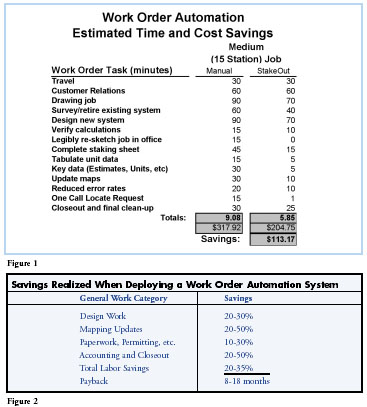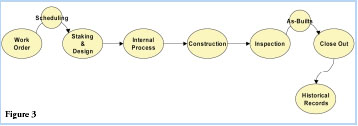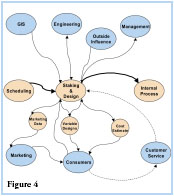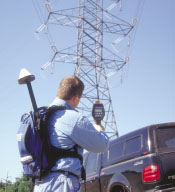Perhaps the last process to be automated at a utility is the design, staking and work order process. This article highlights common problems involved in the traditional staking and work order process and makes a case for implementing a work order automation system as a solution.
Generally one of the most inefficient utility processes is the design, staking and work order process. Utilities have traditionally relied on the pen and paper method of staking work orders, a practice that is time consuming, prone to error and burdened with inefficiencies. In response to market pressures to streamline operations, utilities are looking to eliminate manual processes and automate workflow. While most utilities have spent large amounts of time and money implementing robust CIS and GIS systems, frequently the design, staking and work order process remains a manual, paper-driven procedure.
Figure 1 illustrates how a work order automation system can reduce the time required to complete a typical, medium sized work order. Time savings are realized both in the field and back at the office. Based on these numbers, utilities typically find a return on investment within 8-18 months. These figures are simplified as percentages in Figure 2. Using these percentages gives utilities a ballpark estimate of how a work order automation system will help save time and money.
Utilities stand to gain much by automating this crucial process. Not only can the manual staking and work order process be automated in and of itself – tasks such as sketching designs and printing staking sheets – but it also serves as the front-end data source for the CIS, GIS and other systems. This automated process can serve as the final link in completing the digital workflow chain throughout the entire utility, saving time and money.
Problem of Traditional Design, Staking & Work Order Practices
The design, staking and work order process typically begins in the field, where a staking technician designs a proposed change to the distribution system. The staking technician will typically travel to the work site and draw a sketch from scratch using a pencil and paper. The staker must draw all background information needed by the construction crew and sketch in all existing and proposed new construction. From this sketch a staking (construction) sheet is created. The staking sheet is sometimes drawn on-site, but more often back at the office. On each page of the staking sheet is a grid for units, conductor spans, poles and any other unit information pertaining to the design. Often times each page of the grid includes a small section for re-drawing a section of the design pertinent to that page. As one might imagine, drawing a proposed design and filling out staking sheet grids is time consuming and subject to human error.
Creating accurate staking sheets can also frequently require extra trips to the field. Lost or inaccurate drawings and incomplete field notes are obstacles to creating an accurate design inventory back at the office. Likewise, entering this data into the CIS/accounting system proves to be time consuming, tedious and often inaccurate. Someone must manually key in a large amount of data, which must often times be entered into more than one system.
In short, several problems plague the traditional work order process:
Work Order Automation as a solution
As utilities deal with an increase in work orders due to growth and pressure to streamline operations, it becomes increasingly clear that automating the staking and work order process can yield significant benefits and cost savings. Just a few of these are:
The Work Order Process as a Whole
Automating the staking process is just one piece of the entire work order process. In addition to increased efficiency in staking and design processes, utilities realize the greatest gain in time and money savings when automating the entire work order process. Figure 3 shows a how a work order moves through the work order process at a typical utility. A work order automation system can maximize efficiency at each point throughout the process.
To focus specifically on the scheduling, staking and design steps, Figure 4 illustrates how a work order’s scheduling and design are dependent on a number of inside (departmental) and outside (customer and supplier) influences. Implementing a work order automation system helps manages these influences by sharing crucial work order information between the groups shown, as well as by tracking where in the process the work order resides.
In addition to these features, some of the key benefits of implementing a work order automation system are:
How it Works
An automated staking and work order package uses a variety of components that work together to automate the whole work order process from initial design to final construction.
In the field stakers use handheld pen tablet computers to perform their design work. This process involves drawing from scratch or staking directly in top of an imported background map. Using a pen-based computer allows the staker to design the work order using a familiar methodology – with a pen – while simplifying the design process. Mobile technology also allows for seamless GPS data acquisition and use of laser rangefinders for calculating backspans and GPS offsets.
Once the design is completed in the field a large portion of the back office work order process is already complete. Instead of manually filling out staking sheets the staking technician simply prints them out instantly. Likewise, unit reports, material lists, cost estimates, permits and countless other forms can be readily generated from this data and accessed by work order clerks, construction crews, engineering managers and anyone else involved in the work order process.
The work order may pass through any number of departments until final approval, construction and close-out. At each step along the way the work order automation system will assign different job statuses in a manner fitting the utility’s work flow process. In this way, the work order process becomes centered around the sketch-driven data entry in the field. Once the job has been designed digitally, no data re-entry is necessary, the job is tracked throughout the process and the associated GIS and CIS systems are updated efficiently.
Automated staking and work order automation tools are technologies that provide utilities substantial return on investment by decreasing operating costs, improving productivity and increasing communication of important work order data throughout the utility. As utilities look to improve efficiency and bring the work order process into the digital age, the technology ecists to meet that goal while tying together other systems and completing the digital work flow
chain.
About the Author
Barry Halvorson is a marketing manager for MiniMax Software Corporation, a software development company located in St. Paul, Minnesota. MiniMax is the leading provider of automated staking and work order automation tools to the electric utility industry. Its flagship product, StakeOut, automates the design, staking and work order process from design to construction. For further information contact: bhalvorson@minimax.net
Generally one of the most inefficient utility processes is the design, staking and work order process. Utilities have traditionally relied on the pen and paper method of staking work orders, a practice that is time consuming, prone to error and burdened with inefficiencies. In response to market pressures to streamline operations, utilities are looking to eliminate manual processes and automate workflow. While most utilities have spent large amounts of time and money implementing robust CIS and GIS systems, frequently the design, staking and work order process remains a manual, paper-driven procedure.

Figure 1 illustrates how a work order automation system can reduce the time required to complete a typical, medium sized work order. Time savings are realized both in the field and back at the office. Based on these numbers, utilities typically find a return on investment within 8-18 months. These figures are simplified as percentages in Figure 2. Using these percentages gives utilities a ballpark estimate of how a work order automation system will help save time and money.
Utilities stand to gain much by automating this crucial process. Not only can the manual staking and work order process be automated in and of itself – tasks such as sketching designs and printing staking sheets – but it also serves as the front-end data source for the CIS, GIS and other systems. This automated process can serve as the final link in completing the digital workflow chain throughout the entire utility, saving time and money.
Problem of Traditional Design, Staking & Work Order Practices
The design, staking and work order process typically begins in the field, where a staking technician designs a proposed change to the distribution system. The staking technician will typically travel to the work site and draw a sketch from scratch using a pencil and paper. The staker must draw all background information needed by the construction crew and sketch in all existing and proposed new construction. From this sketch a staking (construction) sheet is created. The staking sheet is sometimes drawn on-site, but more often back at the office. On each page of the staking sheet is a grid for units, conductor spans, poles and any other unit information pertaining to the design. Often times each page of the grid includes a small section for re-drawing a section of the design pertinent to that page. As one might imagine, drawing a proposed design and filling out staking sheet grids is time consuming and subject to human error.
Creating accurate staking sheets can also frequently require extra trips to the field. Lost or inaccurate drawings and incomplete field notes are obstacles to creating an accurate design inventory back at the office. Likewise, entering this data into the CIS/accounting system proves to be time consuming, tedious and often inaccurate. Someone must manually key in a large amount of data, which must often times be entered into more than one system.
In short, several problems plague the traditional work order process:
- Limited access to information. Paper staking sheets and other records limit employee’s access to work order information across the utility. Relying on paper records prohibits more than one employee or department access to information, unless duplicate records are created, which is wasteful and problematic.
- Redundant data entry/re-entry. A work order typically moves through a rather long process from initial design to final close out. Data entry occurs several times throughout that process: into accounting, inventory, CIS and mapping/GIS.
- Prone to mistakes. Data re-entry and maintaining multiple records wastes time and increases the chance of error.
- Information prone to loss, fire, theft, etc. Paper records are not only fragile and prone to loss, but also bulky and expensive to store. Digitizing the process cuts down on paper consumption and storage needs.
Work Order Automation as a solution
As utilities deal with an increase in work orders due to growth and pressure to streamline operations, it becomes increasingly clear that automating the staking and work order process can yield significant benefits and cost savings. Just a few of these are:
- Quicker data entry. By using mobile, pen-based tablet computers in the field, stakers don’t need to hand-tabulate unit, pole and conductor information – they simply drop them in and let the computer perform the calculations.
- Less work back in the office. Using an automated staking system in the field eliminates the need to re-sketch and re-tabulate staking sheets back in the office. Once a job is designed a staking sheet is printed automatically.
- Reduces chances for mistakes. An automated staking system guides the user through the design, prompting for missing units and alerting users to design flaws that violate a rule-base.
- GPS and laser rangefinder connectivity. The use of a mobile computer allows the staker to collect GPS data for each station and calculate spans between stations using a laser rangefinder.
- Neater and cleaner staking sheets. Staking sheets, along with unit and material lists, faxlocate forms, cost-estimates and any other forms can be generated in the field for customer reference, or back in the office.

The Work Order Process as a Whole
Automating the staking process is just one piece of the entire work order process. In addition to increased efficiency in staking and design processes, utilities realize the greatest gain in time and money savings when automating the entire work order process. Figure 3 shows a how a work order moves through the work order process at a typical utility. A work order automation system can maximize efficiency at each point throughout the process.
To focus specifically on the scheduling, staking and design steps, Figure 4 illustrates how a work order’s scheduling and design are dependent on a number of inside (departmental) and outside (customer and supplier) influences. Implementing a work order automation system helps manages these influences by sharing crucial work order information between the groups shown, as well as by tracking where in the process the work order resides.

In addition to these features, some of the key benefits of implementing a work order automation system are:
- Integrate with mapping/GIS. Utilities often spend very large amounts of money implementing a mapping/GIS system, yet struggle with the issue of keeping that data up-to-date. Interfacing with an automated staking system allows the field staking processes to act as a front end to the GIS, resulting in updated maps and better background data on the staking sheets.
- Eliminates data re-entry into CIS. All unit, pole and conductor data is tabulated automatically by the staking system. When tied to the CIS, a simple file transfer eliminates the time consuming and error prone process of re-entering that data.
- Allows reporting options. Database-driven technology allows the utility to analyze staking trends and forecast for future needs. This benefit becomes increasingly useful as the utility amasses multiple years’ worth of staking and work order data. Managerial reports can be run on that data to help the utility make informed decisions relating to productivity, cost of goods and forecasting.
- Reduce the cycle time of a work order from initiation to final close out.
- Increases access to information. Utility-wide access to digital work order information results in improved responsiveness and communication between departments.
How it Works
An automated staking and work order package uses a variety of components that work together to automate the whole work order process from initial design to final construction.
In the field stakers use handheld pen tablet computers to perform their design work. This process involves drawing from scratch or staking directly in top of an imported background map. Using a pen-based computer allows the staker to design the work order using a familiar methodology – with a pen – while simplifying the design process. Mobile technology also allows for seamless GPS data acquisition and use of laser rangefinders for calculating backspans and GPS offsets.
Once the design is completed in the field a large portion of the back office work order process is already complete. Instead of manually filling out staking sheets the staking technician simply prints them out instantly. Likewise, unit reports, material lists, cost estimates, permits and countless other forms can be readily generated from this data and accessed by work order clerks, construction crews, engineering managers and anyone else involved in the work order process.

The work order may pass through any number of departments until final approval, construction and close-out. At each step along the way the work order automation system will assign different job statuses in a manner fitting the utility’s work flow process. In this way, the work order process becomes centered around the sketch-driven data entry in the field. Once the job has been designed digitally, no data re-entry is necessary, the job is tracked throughout the process and the associated GIS and CIS systems are updated efficiently.
Automated staking and work order automation tools are technologies that provide utilities substantial return on investment by decreasing operating costs, improving productivity and increasing communication of important work order data throughout the utility. As utilities look to improve efficiency and bring the work order process into the digital age, the technology ecists to meet that goal while tying together other systems and completing the digital work flow
chain.
About the Author
Barry Halvorson is a marketing manager for MiniMax Software Corporation, a software development company located in St. Paul, Minnesota. MiniMax is the leading provider of automated staking and work order automation tools to the electric utility industry. Its flagship product, StakeOut, automates the design, staking and work order process from design to construction. For further information contact: bhalvorson@minimax.net







